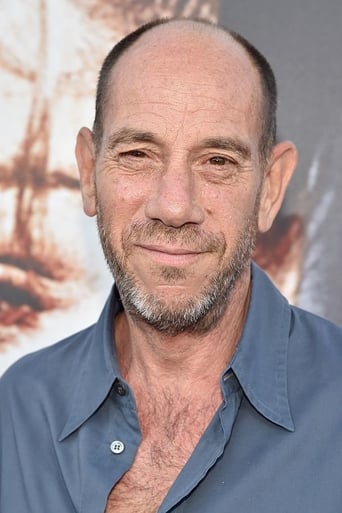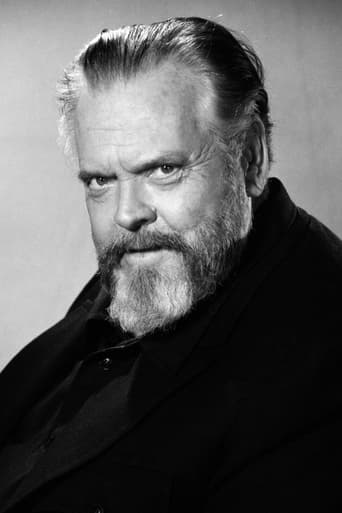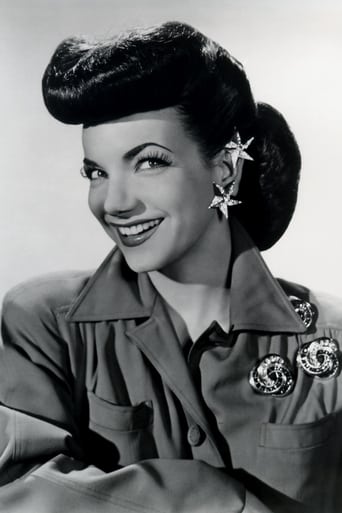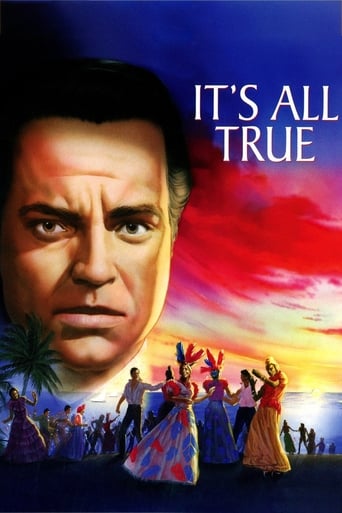
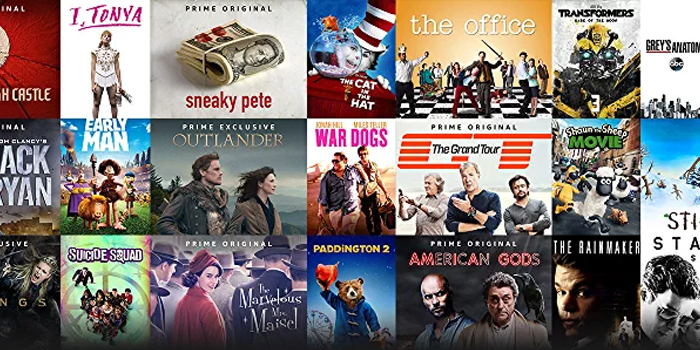
It's All True (1993)
A documentary about Orson Welles's unfinished three-part film about South America.
Watch Trailer
Cast
Reviews
Admirable film.
Absolutely Brilliant!
It's funny watching the elements come together in this complicated scam. On one hand, the set-up isn't quite as complex as it seems, but there's an easy sense of fun in every exchange.
Actress is magnificent and exudes a hypnotic screen presence in this affecting drama.
It's All True (1993)*** (out of 4) Fascinating documentary about the trouble Orson Welles fell into with RKO when he finished up THE MAGNIFICENT AMBERSONS and went to Brazil to film what was basically a South American trilogy. Welles was involved in three films: MY FRIEND BONITO, filmed in Mexico about a boy and his donkey; CARNAVAL, which footage shown here is in glorious Technicolor; and FOUR MEN ON A RAFT, which contains the majority of the footage here. IT'S ALL TRUE isn't going to be a movie for everyone and I'd imagine that most people would find it deadly dull and lifeless. Film buffs, however, should get a real kick out of it but the sad thing is that you could remake this movie a dozens times because it happened so often to Welles. The documentary starts off at the end of CITIZEN KANE when Welles was already considered controversial. It then moves onto the disastrous screening of THE MAGNIFICENT AMBERSONS where Welles thought he'd have a chance to re-edit the movie but instead the studio did it behind his back. We then get into the filming of the three films and learn of the various issues that happened including the lack of money, a curse from a voodoo man and eventually the studio taking the films away. In a bit of great luck, the footage to the three movies were discovered in 1985 and seeing the footage is interesting. CARNAVAL really stuck out to me because of the amazing colors, which just leap off the screen in Technicolor. The footage looks remarkably well and just look at the wonderful details in the costumes that the people are wearing. The stuff on FOUR MEN ON A RAFT has the most footage and also gets quite a bit of a backstory about the real event, the real tragedy and of course how Welles got involved and what he did to try and save the film. Film buffs and fans of Welles will certainly want to check this out. We get some nice interviews with people who worked on the film as well as relatives to those actual people that the film is based on.
It is by sheer luck sometimes that an artist's work survives. For centuries the works of the Greek dramatist Menander did not exist except for occasional quotes (including "whom the Gods love die young"). But since 1905 one complete play, one nearly complete play, and five huge fragments exist to be studied by drama students. They were found on various papyri that managed to survive in the dry climate of Egypt.With Orson Welles there are several films which are seriously missing scenes he shot that were cut. THE MAGNIFICENT AMBERSONS is the best known (cut and a new ending attached), but there is also THE STRANGER, THE LADY FROM SHANGHAI, CONFIDENTIAL REPORT, MACBETH, and IT'S ALL TRUE to ponder. Welles had a way of making enemies due to his ego, but he was a brilliant film maker, and to see the damage these pygmies did to his work makes one angry. The fate of Konrad Meinike in THE STRANGER was to be the culmination of half an hour of activity in the film showing his escape from prison in Europe and his traveling to Latin America to locate the man he worked with - who would kill him. The famous crazy house sequence in THE LADY FROM SHANGHAI is only a small segment now of what Welles shot (that segment is still great, but the missing footage probably was superb). Restoration on CONFIDENTIAL REPORT makes it coherent now, and MACBETH now has it's original length and soundtrack. TOUCH OF EVIL too has been somewhat repaired based on the memos Welles left of his intentions for the film.IT'S ALL TRUE, unlike the other films, was never completed enough in any form to be shown to the public. Welles went to Latin America, having finished shooting AMBERSONS, and was to do a "good neighbor policy" documentary for the Roosevelt administration under the auspices of Nelson Rockefeller. He had to also cut AMBERSONS, and his finished cut version was butchered by his enemies at RKO who had it's end re-shot. Political differences with the Brazilian strongman, Getulio Vargas, helped doom IT'S ALL TRUE, and caused the footage to be left on a shelf to rot rather than to be released.Over the years film historians noted it's existence, until finally in 1990 or so some began preserving and editing the best surviving footage. Unfortunately much of the sections on "MY FRIEND BONITO" and of "The STORY OF SAMBA" was lost, but enough lasts to show Welles' eye for film was working brilliantly. Fortunately the last section, "FOUR MEN ON A RAFT" survived, and could be put into coherent form. It told the story of four poor fishermen from the north - east corner of the country with grievances, who sailed a raft (with one or two stops) all the way to Rio, in order to see President Vargas. They managed to do it. But Vargas did not really help these fisherman (one of whom was killed apparently when Welles was filming the sequence). The sequence is not only moving, but also extremely beautiful to look at. One gets the impression that Welles' Latin American documentary would have been a gorgeous one.The version of IT'S ALL TRUE is the closest we will ever have to what Welles meant to show. I recommend watching it, with the commentary sequences showing Welles at work, and his explaining the way things went wrong. Enjoy what is left. It is worth seeing.
This is certainly not the movie Welles would have made. Welles would have made something far more interesting; even his worst films have a certain fascinating quality but this is really pretty dull. They've taken his footage, strung it together in order attached a bland score that adds nothing to it and put a dull little documentary in front so you would understand what you were seeing. It's an interesting curio for film buffs, and there are some striking images, but don't kid yourself; this isn't even remotely what Welles would have created. This is a workmanlike construct using some tools created by Welles, that's all. This is not like rediscovering a Bach concerto, it's more like a piece of music written based on a description of a Bach concerto by someone who doesn't quite remember how it goes.
I loved this examination of Welles' South American misadventures, because it challenged and successfully overturned my prejudices towards Welles; namely, that in his early years he squandered much of his talent and potential while becoming Hollywood's "bad boy," partying in the streets of Rio on RKO's tab until they had no choice but to pull the plug on his project. Instead, the filmmakers paint a much more sincere portrait of Welles as a committed filmmaker and artist, with circumstances beyond his control ultimately destroying not just his hard work, but the hopes of an entire oppressed underclass.Amazingly, the filmmakers were able to locate the survivors (and their relatives) to piece together, first the chronology of Welles' stay in Brazil, and eventually the raw footage itself, to give us at least a glimpse of what Welles had planned to release. It's also a fascinating look at the early documentary tradition pioneered by Robert Flaherty and John Grierson (though ultimately I think the evidence suggests Welles may have been more influenced by Eisensteinian agit-prop).For anyone interested in a sympathetic portrayal of American cinema's most praised and controversial director, I highly recommend IT'S ALL TRUE.
